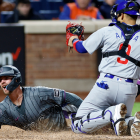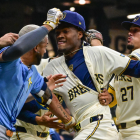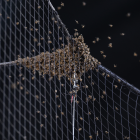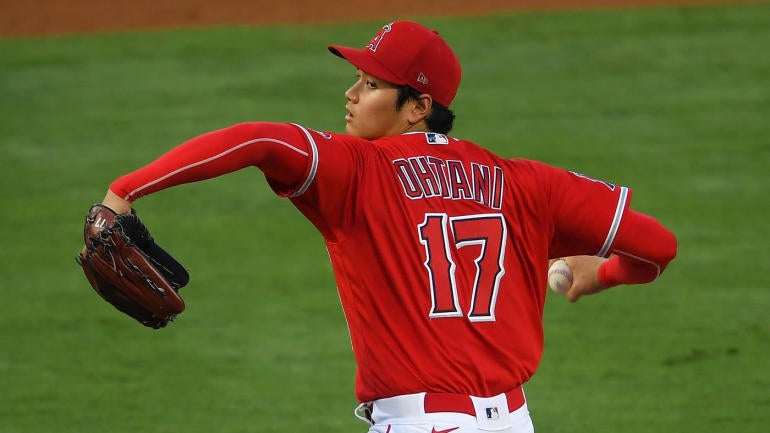
I know it feels like the 2021 MLB season is just getting underway, but we're now closer to the trade deadline (seven weeks and two days) than we are Opening Day (nine weeks and six days). That happened fast, huh? The All-Star break is only five weeks away.
Our weekly series examining various trends across the league continues with a look at one of the game's biggest starts getting his control locked in, a young player improving is plate discipline, and one team's issue with free passes. Last week we broke down Tommy Pham's hot streak, Rich Hill's historic success, and a rough month for the Astros bullpen.
Ohtani cutting down on walks
Last Friday, Angels star Shohei Ohtani turned in the finest start of his MLB career, holding an admittedly weak Mariners lineup to two runs on four hits in six innings. He struck out 10 and was pulled after 76 pitches only because the club is keeping close tabs on his workload. The most important number: 0, as in zero walks. Ohtani did not walk a batter for the first time in 20 MLB starts.
"He's full of confidence and knows where his release point is," Angels manager Joe Maddon told reporters, including MLB.com's Rhett Bollinger, following the game. "I also believe the fastball command is getting better and it makes his splitter and cutter even better because you have to honor his fastball. It was a great one to build off of and there's no reason to believe he can't build on that."
Not only was Friday the first time Ohtani did not walk a batter in an MLB start, it was the first time he didn't walk a batter in the first five innings since joining the Angels. The walks tend to come early and often. Now though, Ohtani has walked only seven of the 92 batters he faced in his last four starts (7.6 percent). In his first four starts, he walked 19 of 84 batters (22.6 percent).
A graph is worth a thousand words, so here is Ohtani's rate of pitches in the strike zone this season:
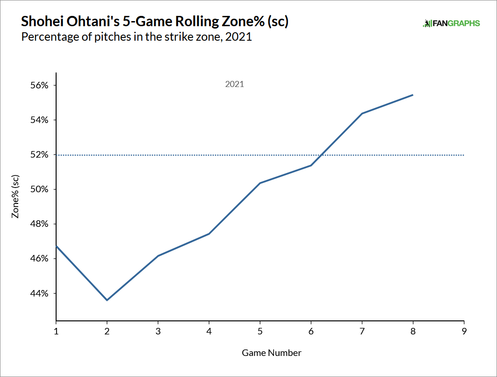
A positive trend, that is. Ohtani's zone rate with his fastball has improved the most, sitting in the 60 percent range his last four starts after dipping down below 40 percent earlier this year. Ohtani is one of the hardest throwers in the sport -- his 95.5 mph average fastball velocity is a top-20 mark in baseball -- and when he's pitching with his fastball in the zone, hitters have to respect the velocity, and that in turn makes his slider and devastating splitter more effective.
Control is often the last thing to return following Tommy John surgery -- Ohtani walked eight of the 16 batters he faced in his brief return to the mound last season -- and Ohtani needing 40-ish innings to get right would not be unprecedented. Add in the fact he had an unusual rehab simply because he's a hitter as well, and yeah, it's understandable that he'd need some time to iron out his control post-elbow reconstruction. Now it appears Ohtani is back on track.
My biggest concern at this point is fatigue. Ohtani's shown the ability to dominate on the mound and at the plate, but he's over 400 combined plate appearances as a hitter and batters faced as a pitcher this year, by far the most in baseball, and he's appeared in all but five of the team's 60 games. Ohtani is young (26) and strong, but at some point the Angels will have to rein him in a bit, especially if they continue to sit outside the postseason picture. There's no reason to push him in a lost year.
Baddoo showing improved plate discipline
Tigers outfielder Akil Baddoo had a storybook beginning to his MLB career. The 22-year-old Rule 5 Draft pick from the Twins hit a home run on the first pitch he saw as a big leaguer, then he hit a grand slam the next day, and then he hit a walk-off single the day after that. Two home runs and a walk-off single make for a pretty great three-game stretch to begin a career.
Baddoo fell on hard times after that, however. He went 10 for 55 (.182) with 27 strikeouts and only two walks in his next 17 games, and finished April with a .222 batting average and a .242 on-base percentage. His slash line bottomed out at .192/.231/.493 on May 6, and he'd struck out in nearly half his plate appearances. MLB pitchers quickly caught on to the rookie.
In his next 20 games though, Baddoo adjusted back, and went 13 for 39 (.333) with more walks (14) than strikeouts (13). He went into Tuesday's game hitting .241/.341/.500 in 132 plate appearances this year overall. That is damn good for a kid who missed a lot of time with injuries in his career, and skipped right over Double-A and Triple-A.
"Just get back to taking what the pitcher was giving me and putting a good swing on it," Baddoo told reporters, including Chris McCosky of the Detroit News, last week. "I'm a strong fella so I need to trust that and use my legs and not try to do too much. I was kinda doing a little too much there early. I've learned to stay more relaxed and let the game come to me."
Not surprisingly, Baddoo's chase rate (O-Swing%) and swinging strike rate (SwStr%) have been dropped considerably these last few weeks. They're still higher than the league averages, but they're trending in the right direction.
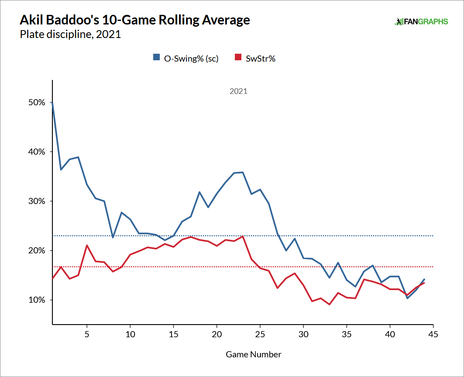
To be clear, Baddoo did not come out of nowhere. Baseball America ranked him among Minnesota's top 20 prospects every year from 2017-20, and our R.J. Anderson noted Baddoo possesses an "intriguing power and speed combination." The kid has ability, but going from High-A in 2019 to a lost season in 2020 (the Twins didn't invite Baddoo to their alternate site) to the big leagues in 2021 was never going to be easy. The fact he's adjusted so quickly is a testament to his work ethic and baseball acumen.
The Tigers went 14-13 in May, their first winning month since May 2018 (15-14). Casey Mize and Tarik Skubal are beginning to look like rotation mainstays, and although Baddoo is being used in a strict platoon role, he's shown enough improvement already to figure into the team's long-term plans. If there was ever a year for a player to fall through the cracks in the Rule 5 Draft, this was it because of the lost 2020 minor-league season, and it sure looks like Detroit has found a keeper in Baddoo.
"Really, it's just having a game plan and sticking to what got you here," Baddoo told McCosky. "It's just about staying mentally strong throughout the whole process. There's been a lot of ups and downs, but I just took what the coaches and the veteran players were giving me and I made my own routine, my own plan on how to attack the game of baseball."
Cardinals having major walk problems
The Cardinals are currently dealing with something of a pitching crisis. Staff ace Jack Flaherty is expected to miss quite some time with an oblique strain, and the club also lost starters Miles Mikolas (forearm tightness) and Kwang Hyun Kim (back tightness) to the injured list. They're also without Dakota Hudson, who will miss the season rehabbing from Tommy John surgery.
St. Louis has also experienced a free baserunners crisis this year. Going into Tuesday's action, their team walk rate of 11.6 percent was the highest in baseball by a significant margin (the Reds were second at 10.9 percent), and it is on pace to be the highest walk rate since the 1996 Tigers walked 11.9 percent of the batters they faced. Detroit went 53-109 that year.
On May 15, Cardinals pitchers walked 12 Padres, their most walks in a nine-inning game since 2004. St. Louis pitchers only had to pitch eight innings in that May 15 game because it was a road loss, I should note. The bottom of the ninth was not played. Cardinals pitchers lead baseball this season with ...
- ... three 10-walk games.
- ... four nine-walk games.
- ... six eight-walk games.
- ... nine seven-walk games.
- ... 16 six-walk games.
- ... 26 five-walk games.
- ... 39 four-walk games.
- ... 47 three-walk games.
- ... 56 two-walk games.
It's not good when you're leading the world in games at each walk level. Also, only once this season have the Cardinals not issued a walk in a game. That was April 26 against the Phillies, when Adam Wainwright was at his best and struck out eight in a 107-pitch complete game. That's what it takes for the Cardinals to get through a game without issuing a free pass these days.
"That's not a good recipe for winning," Cardinals pitching coach Mike Maddux told reporters, including Derrick Goold of the St. Louis Post-Dispatch, following that 12-walk game on May 15. "... We can't pitch not to walk people. We have to pitch to get outs. You also have to utilize your defense, which is one of the team strengths."
As ESPN's Buster Olney noted this past weekend, the Cardinals have 19 walks and hit batsmen with the bases loaded this season, nine more than any other team. Those 19 also tie their most in an entire season (also 19 in 2009), and they still have over 100 games to play. Even with the deadened baseball, this many walks can sink your pitching staff, and it's not a coincidence keep runs off the board has been difficult during the club's recent slide.






















